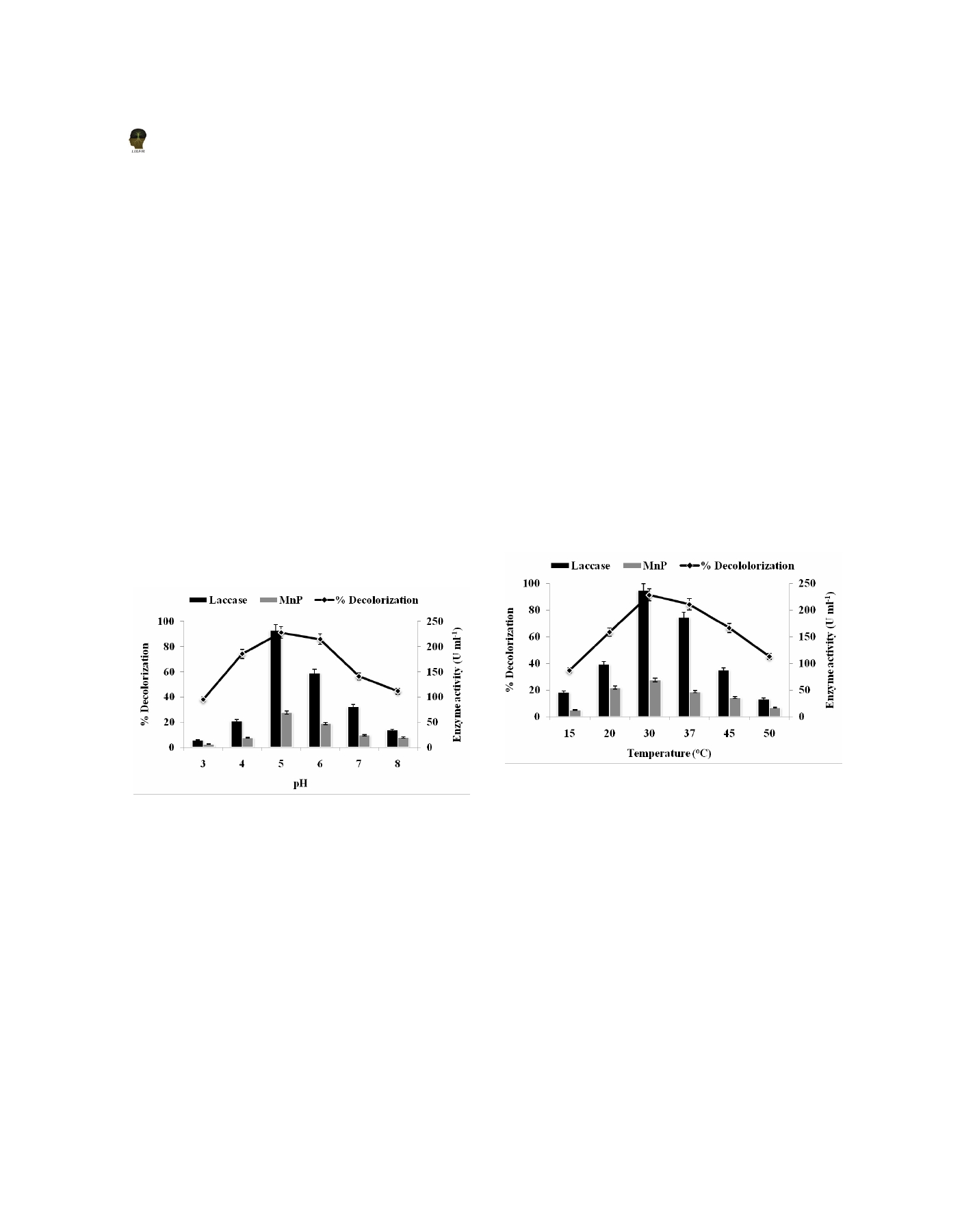
Prajapati et al.
is depicted in figure 5. The linear relationship between
concentration thereafter. However, the isolate AGYP-1
incubation temperature and color removal was observed in
was quite stable and exhibited 74.34% decolorization at
the temperature range of 15 to 30 o C. The isolate exhibited
500 mg l -1 Reactive Red M5B concentration. Moreover,
maximum decolorization of the dye (91.34±4.5%) along
the decolorization rate increased from 7.68 to 30.97 mg
with 237.17±11.3 U ml -1 and 68.13±5.4 U ml -1 activities
dye day -1 with an increase in initial dye concentration from
of laccase and MnP respectively at 30 o C. The dye was
100 to 500 mg l -1 explaining a typical Monod-type profile.
decolorized 84.32±3.9% at 37 o C, and the color removal
Under experimental conditions, the correlation between
activity of the isolate was severely reduced at 50 o C.
decolorization rate (R D ) and initial dye concentration
The fungal growth was highest (0.258±0.04 g) at 30 o C
([RRM5B]) was obtained by Michaelis-Menten double
indicating an optimum temperature for the growth, enzyme
reciprocal model ( R
D max
[RRM5B] / (K m + [RRM5B]).
production and decolorization activity of the isolate
The values of an apparent maximum decolorization rate
AGYP-1. Different fungi grow at different optimum
( R
D max
) and Michaelis constant (K m ) were 128.20 mg dye
temperatures, with most of them growing at 25-35 o C (Fu
day -1 and 166.66 mg l -1 respectively. Above results thus
and Vararaghavan 2001). Similar results were reported
demonstrate a good capability of the isolate AGYP-1 for
by Gahlout et al . (2013), stating that the decolorization
the decolorization of higher concentration of the dye. The
of Reactive Violet 1 was maximum at 30 o C and lesser
effect of Malachite Green concentration on decolorization
decolorization was observed at 45 o C using Ganoderma
capacity of white rot fungus Dichomitus squalens has
cupreum AG-1. Beyond the optimum temperature, the
been studied; wherein the dye at 50 mg l -1 concentration
slower growth and deactivation of enzymes responsible
inhibited the fungal growth (Eichlerova et al ., 2006).
for degradation are main reasons for decreased degradation
activities of the microorganisms (Ali, 2010).
Figure 5: Effect of incubation temperature on
decolorization of Reactive Red M5B by isolate AGYP-1
Figure 4: Effect of pH on decolorization of Reactive Red
M5B by isolate AGYP-1
3.4.5 Effect of co-substrate
3.4.4 Effect of initial dye concentration
In general, dyes are deficient in carbon content and their
degradation without any extra carbon and nitrogen source
The decolorization capability of the isolate AGYP-1 was
is found to be very difficult (Stolz, 2001). In order to
studied by varying initial dye concentration (100-500 mg
evaluate the effect of co-substrate, the decolorization of
l -1 ) under shaking condition. Maximum decolorization of
Reactive Red M5B by isolate AGYP-1 was monitored in
Reactive Red M5B (92.18±2.2%) was observed at 100
the presence of various carbon sources. Variable results
mg l -1 concentration (Fig. 6). A marginal reduction in
of decolorization of the dye were obtained with different
decolorization efficiency of the isolate was observed at
co-substrates tested (Table 2). The decolorization
200 mg l -1 concentration (86.45±4.5%). The decolorization
performance of the isolate AGYP-1 was better in the
of the dye was decreased with increase in initial dye
presence of maltose (96.11±2.7%) with maximum laccase
506